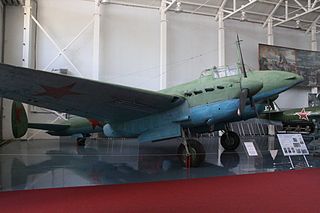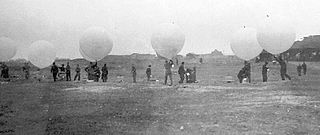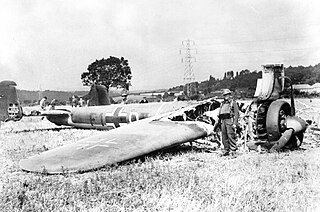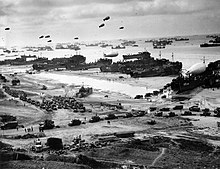
A bomber is a military combat aircraft designed to attack ground and naval targets by dropping air-to-ground weaponry, launching torpedoes, or deploying air-launched cruise missiles. The first use of bombs dropped from an aircraft occurred in the Italo-Turkish War, with the first major deployments coming in the First World War and Second World War by all major airforces causing devastating damage to cities, towns, and rural areas. The first purpose built bombers were the Italian Caproni Ca 30 and British Bristol T.B.8, both of 1913. Some bombers were decorated with nose art or victory markings.

The V-1 flying bomb was an early cruise missile. Its official Reich Aviation Ministry (RLM) designation was Fi 103 and its suggestive name was Höllenhund (hellhound). It was also known to the Allies as the buzz bomb or doodlebug and in Germany as Kirschkern or Maikäfer (maybug).

A military aircraft is any fixed-wing or rotary-wing aircraft that is operated by a legal or insurrectionary military of any type. Military aircraft can be either combat or non-combat:

Anti-aircraft warfare, counter-air, anti-air, AA guns, layered air defence or air defence forces is the battlespace response to aerial warfare, defined by NATO as "all measures designed to nullify or reduce the effectiveness of hostile air action". It includes surface based, subsurface, and air-based weapon systems, associated sensor systems, command and control arrangements, and passive measures. It may be used to protect naval, ground, and air forces in any location. However, for most countries, the main effort has tended to be homeland defence. NATO refers to airborne air defence as counter-air and naval air defence as anti-aircraft warfare. Missile defence is an extension of air defence, as are initiatives to adapt air defence to the task of intercepting any projectile in flight.

A dive bomber is a bomber aircraft that dives directly at its targets in order to provide greater accuracy for the bomb it drops. Diving towards the target simplifies the bomb's trajectory and allows the pilot to keep visual contact throughout the bomb run. This allows attacks on point targets and ships, which were difficult to attack with conventional level bombers, even en masse.

An attack aircraft, strike aircraft, or attack bomber is a tactical military aircraft that has a primary role of carrying out airstrikes with greater precision than bombers, and is prepared to encounter strong low-level air defenses while pressing the attack. This class of aircraft is designed mostly for close air support and naval air-to-surface missions, overlapping the tactical bomber mission. Designs dedicated to non-naval roles are often known as ground-attack aircraft.

The Dornier Do 217 was a bomber used by the German Luftwaffe during World War II as a more powerful development of the Dornier Do 17, known as the Fliegender Bleistift. Designed in 1937 and 1938 as a heavy bomber but not meant to be capable of the longer-range missions envisioned for the larger Heinkel He 177, the Do 217's design was refined during 1939 and production began in late 1940. It entered service in early 1941 and by the beginning of 1942 was available in significant numbers.

The Petlyakov Pe-2 was a Soviet twin-engine dive bomber used during World War II. One of the outstanding tactical attack aircraft of the war, it also proved successful as a heavy fighter, as a night fighter and as a reconnaissance aircraft. The Pe-2 was, numerically, the most important Soviet bomber of World War II, at their peak comprising 75% of the Soviet twin-engine bomber force. The Soviets manufactured Pe-2s in greater numbers during the war than any other twin-engine combat aircraft except for the German Junkers Ju 88 and the British Vickers Wellington. Several communist air forces flew the type after the war, when it became known by the NATO reporting name Buck.

World War I was the first major conflict involving the large-scale use of aircraft. Tethered observation balloons had already been employed in several wars, and would be used extensively for artillery spotting. Germany employed Zeppelins for reconnaissance over the North Sea and Baltic and also for strategic bombing raids over Britain and the Eastern Front.

In aeronautics, a balloon is an unpowered aerostat, which remains aloft or floats due to its buoyancy. A balloon may be free, moving with the wind, or tethered to a fixed point. It is distinct from an airship, which is a powered aerostat that can propel itself through the air in a controlled manner.

Military aviation comprises military aircraft and other flying machines for the purposes of conducting or enabling aerial warfare, including national airlift capacity to provide logistical supply to forces stationed in a war theater or along a front. Airpower includes the national means of conducting such warfare, including the intersection of transport and warcraft. Military aircraft include bombers, fighters, transports, trainer aircraft, and reconnaissance aircraft.

Operation Outward was a British campaign of the Second World War that attacked Germany and German-occupied Europe with free-flying balloons. It made use of cheap, simple balloons filled with hydrogen and carrying either a trailing steel wire to damage high voltage power lines by producing a short circuit, or incendiary devices to start fires in fields, forests and heathland. A total of 99,142 Outward balloons were launched; about half carried incendiaries and half carried trailing wires.

An airborne wind turbine is a design concept for a wind turbine with a rotor supported in the air without a tower, thus benefiting from the higher velocity and persistence of wind at high altitudes, while avoiding the expense of tower construction, or the need for slip rings or yaw mechanism. An electrical generator may be on the ground or airborne. Challenges include safely suspending and maintaining turbines hundreds of meters off the ground in high winds and storms, transferring the harvested and/or generated power back to earth, and interference with aviation.

Balloons and kites were the first inventions used in aerial warfare and their primary role was observation. Balloons provided an unreliable and stable means of elevating an observer high over the battlefield to obtain a birds-eye view of troop positions and movements. An early instrument of aerial intelligence collection, they were also useful for creating accurate battlefield maps, an important ingredient for battlefield success. Incendiary balloons also have a long history. The incendiary balloons carry hot air or something that can catch fire to destroy enemy territory. They could also hold small bombs for combat. The history of military ballooning dates back to the late 18th century, when the Montgolfier brothers, Joseph-Michel and Jacques-Étienne, first demonstrated the potential of hot-air balloons for military use. The first recorded military use of balloons was during the French Revolutionary Wars, when the French military used balloons to gather intelligence on the movements of the enemy. Balloons were also used during the American Civil War, where they were used for reconnaissance and communication. Balloons had a decline after several incidents in the interwar period.

An observation balloon is a type of balloon that is employed as an aerial platform for gathering intelligence and spotting artillery. The use of observation balloons began during the French Revolutionary Wars, reaching their zenith during World War I, and they continue in limited use today. Synonyms include espionage balloon, reconnaissance balloon, spy balloon, and surveillance balloon.

A kite balloon is a tethered balloon which is shaped to help make it stable in low and moderate winds and to increase its lift. It typically comprises a streamlined envelope with stabilising features and a harness or yoke connecting it to the main tether and a second harness connected to an observer's basket.
The Fairey P.4/34 was a competitor for an order for a light bomber to serve with the Royal Air Force. Although not produced in that form, it formed the basis for the Fulmar long-range carrier-based fighter for the Fleet Air Arm.
For environmental monitoring, Project Grab Bag was an air sampling program conducted in the United States in the stratosphere of above-ground nuclear weapons testing in the Soviet Union.

The Hardest Day was a Second World War air battle fought on 18 August 1940 during the Battle of Britain between the German Luftwaffe and British Royal Air Force (RAF). On that day, the Luftwaffe made an all-out effort to destroy RAF Fighter Command. The air battles that took place on that day were amongst the largest aerial engagements in history to that time. Both sides suffered heavy losses. In the air, the British shot down twice as many Luftwaffe aircraft as they lost. However, many RAF aircraft were destroyed on the ground, equalising the total losses of both sides. Further large and costly aerial battles took place after 18 August, but both sides lost more aircraft combined on this day than at any other point during the campaign, including 15 September, the Battle of Britain Day, generally considered the climax of the fighting. For this reason, Sunday 18 August 1940 became known as "the Hardest Day" in Britain.
Blue Joker was an experimental moored balloon-mounted, airborne early-warning radar project developed by the Royal Radar Establishment (RRE) starting in 1953. The idea was to position the radar high in the air in order to extend its radar horizon and allow it to see low-flying aircraft. Ground reflections were filtered out using a moving target indicator (MTI) system. Two examples were built and tested in the late 1950s, but the project was cancelled in 1960 as part of the Linesman/Mediator efforts.



















